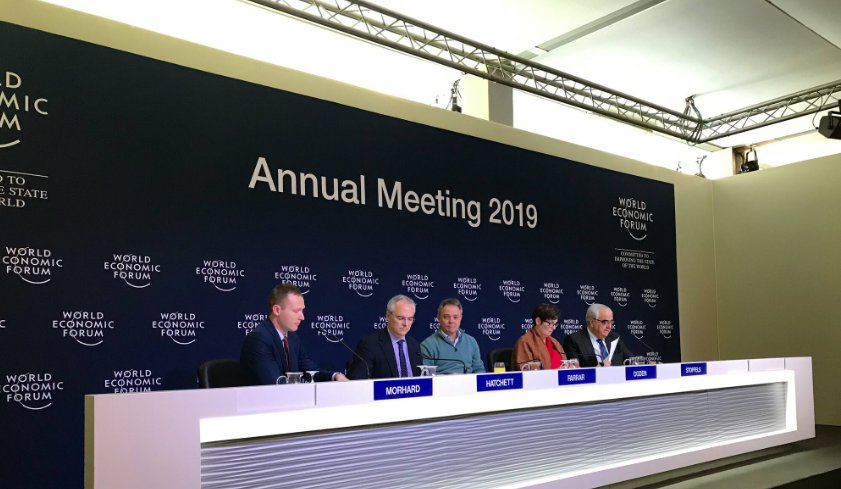
Medical breakthroughs and advances in public health systems have enabled countries to contain the effects of infectious diseases, but these gains are tempered by insecurities from forces in economics, globalization, and synthetic biology.
That was the takeaway from The Global Risks Report 2019 issued by the World Economic Forum where experts made predictions of worsening economic and political confrontations this year between major powers. The report represents the opinion of nearly 1,000 decision makers from the public sector, private sector, academia and civil society about topics ranging from climate change to Ebola.
“In June the world contended with simultaneous outbreaks of six of the eight diseases highlighted in the World Health Organization’s list of priority epidemic diseases,” said Richard Hatchett, CEO of the Coalition for Epidemic Preparedness Innovations (CEPI) during a press conference at the annual meeting of the Forum in Davos, Switzerland. “Epidemics turn the world upside down…and the number of outbreaks seems to be increasing.”
The report cites that between 1980 and 2013, thousands of outbreaks comprised 44 million individual cases affecting all countries. One factor driving the increase in frequency of outbreaks includes international travel and trade as people live in a world where disease can move from a remote village to a city in less than 36 hours. Another aspect of disease spread is high-density living in often unhygienic conditions. By 2050, 68 percent of the global population will live in urban areas.
Urbanization has led to deforestation, another element of the story of disease.
According to the report, “tree-cover loss has been rising steadily over the past two decades and is linked to 31 percent of outbreaks … the WHO has pointed to the potential of climate change to alter and accelerate the transmission patterns of infectious diseases.”
Despite advances in treatments and health infrastructure, outbreaks still cost billions of dollars in economic losses, including one estimate that puts the annual economic cost of potential pandemics in the 21st century at $60 billion.
The financial backing to create vaccines for the 11 infectious diseases highlighted by WHO has fallen short. CEPI — a coalition of countries, public health organizations, pharmaceutical and biotech companies, and academic institutions born two years ago at Davos — has committed to invest $1 billion by 2021 to develop vaccines for Ebola, MERS, Nipah, Rift Valley fever, Zika, and Lassa fever. However, the report suggested it will cost up to $3.7 billion to develop a vaccine for each of the infectious diseases WHO has prioritized.
“Soon we will initiate the first clinical trials of vaccines supported by CEPI,” said Hatchett.
Hatchett explained that the platform technologies CEPI is working on have the potential to transform the way in which vaccines are developed. Early indications are positive they will work and will reduce the time it takes to develop a vaccine from years to weeks, he said.
CEPI also supported MSD (Merck and Co.) in the roll-out of the company’s experimental Ebola vaccine in 2018 in the Democratic Republic of Congo (DRC), a country experiencing the second-largest Ebola outbreak in human history. To date, 60,000 people in the DRC have received the vaccine, said Lydia Ogden, associate vice president, Global Enterprise Policy at MSD, at the press conference.
In recent weeks, the coalition has expanded the number of priority pathogens to five, issuing a third call for proposals and inviting submissions to develop vaccines against Chikungunya and Rift Valley fever. The organization also announced in Davos that the United Kingdom has pledged £10 million in funding as part of a commitment to join CEPI, enhancing its mission of developing vaccines to combat and prevent future epidemics. CEPI’s partnerships support a portfolio of 17 vaccines.
“Although progress has been made, particularly since the 2014–16 Ebola epidemic, most countries have not yet reached minimum international standards of capacity to detect, assess, report and respond to acute public health threats … and the WHO’s Contingency Fund for Emergencies, established in 2015 to enable rapid responses to disease outbreaks and health crises, is funded at only one-third of its annual $100 million target,” the report said.
Beyond these threats, scientists and policymakers are concerned by the growing risks associated with advances in synthetic biology.
When a Canadian research team published in 2018 how they made horsepox, a cousin to the virus that causes smallpox in people, the scientific community worried the results would act as a blueprint for any laboratory to produce smallpox as a bioweapon.
In contrast to other kinds of terrorist attacks, a biologically based attack could be deployed repeatedly for “successive high-impact attacks,” the report said.




